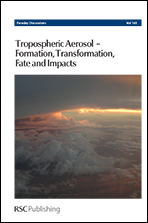Online and offline mass spectrometric study of the impact of oxidation and ageing on glyoxal chemistry and uptake onto ammonium sulfate aerosols†
Abstract
Recent laboratory and modelling studies have shown that reactive uptake of low molecular weight α-dicarbonyls such as glyoxal (GLY) by aerosols is a potentially significant source of secondary organic aerosol (SOA). However, previous studies disagree in the magnitude of the uptake of GLY, the mechanism involved and the physicochemical factors affecting particle formation. In this study, the chemistry of GLY with ammonium sulfate (AS) in both bulk laboratory solutions and in aerosol particles is investigated. For the first time, Aerosol Time of Flight Mass Spectrometry (ATOFMS), a single particle technique, is used together with offline (ESI-MS and LC-MS2) mass spectrometric techniques to investigate the change in composition of bulk solutions of GLY and AS resulting from aqueous photooxidation by OH and from ageing of the solutions in the dark. The mass spectral ions obtained in these laboratory studies were used as tracers of GLY uptake and chemistry in AS seed particles in a series of experiments carried out under dark and natural irradiated conditions at the outdoor European Photo-reactor (EUPHORE). Glyoxal oligomers formed were not detected by the ATOFMS, perhaps due to inefficient absorption at the laser wavelength. However, the presence of organic nitrogen compounds, formed by reaction of GLY with ammonia was confirmed, resulting in an increase in the absorption efficiency of the aerosol, and this increased the number of particles successfully ionised by the ATOFMS. A number of light absorbing organic nitrogen species, including 1H-imidazole, 1H-imidazole-2-carboxaldehyde, 2,2′-bis-imidazole and a glyoxal substituted 2,2′-bisimidazole, previously identified in aqueous laboratory solutions, were also identified in chamber aerosol and formed on atmospherically relevant timescales. An additional compound, predicted to be 1,2,5-oxadiazole, had an enhanced formation rate when the chamber was open and is predicted to be formed via a light activated pathway involving radical oxidation of ammonia to hydroxylamine, followed by subsequent reaction with glyoxal to form an intermediate glyoxime.
- This article is part of the themed collection: Tropospheric Aerosol – Formation, Transformation and Impacts

 Please wait while we load your content...
Please wait while we load your content...